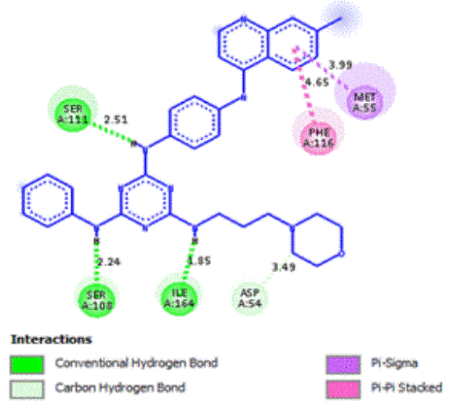
QSAR and Molecular docking studies of 4-anilinoquinoline-triazine hybrids as pf-DHFR inhibitors
Abstract
A quantitative structure-activity relationship (QSAR) investigation was performed towards 41 hybrids of 4-anilinoquinoline-triazines as potential antimalarial agents. The study was carried out using descendant multiple linear regression analyses (MLR), and artificial neural networks (ANN). Quantum chemical descriptors were calculated using DFT-B3LYP method, with the basis set 6-31G. The values obtained for the correlation coefficient of 0.87 and 0.92 by MLR and ANN, respectively, show a good predictive quality of the established model. In addition, the predicted model has been confirmed by several validation methods such as leave-one-out (LOO) cross-validation, Y-randomization, and external validation. The observed activity and the structural features of the studied molecules were further highlighted by molecular docking study on both wild and quadruple mutant type of pf-DHFR protein. Furthermore, the present work deals to study the binding modes and the key protein-ligand interactions. This methodology will be used to design new antimalarial drugs.
Full Text:
PDFReferences
N. Kumar, S. I. Khan, H. Atheaya, R. Mamgain, D. S. Rawat, Synthesis and in vitro antimalarial activity of tetraoxane-amine/amide conjugates, Eur. J. Med. Chem., 2011, 46, 2816-2827.
World Health Organization., WHO | Global Malaria Mapper, WHO. (2018).
J. B. Vaishnani, Cutaneous findings in five cases of malaria, Indian J. Dermatol. Venereol. Leprol., 2011, 77, 110.
M. C. Murray, M. E. Perkins, Chapter 15. Chemotherapy of Malaria, Annu. Rep. Med. Chem., 1996, 31, 141-150.
P. Newton, BM, DPhil, N. White, MALARIA: New Developments in Treatment and Prevention, Annu. Rev. Med., 1999, 50, 179-192.
M. D. Hastings, C. H. Sibley, Pyrimethamine and WR99210 exert opposing selection on dihydrofolate reductase from Plasmodium vivax, Proc. Natl. Acad. Sci., 2002, 99, 13137-13141.
I. B. Müller. J. E. Hyde, Antimalarial drugs: modes of action and mechanisms of parasite resistance, Future Microbiol., 2010, 5, 1857-1873.
F. W. Muregi, A. Ishih, Next-generation antimalarial drugs: hybrid molecules as a new strategy in drug design, Drug Dev. Res., 2009, 7, 20-32.
A. Kumar et al., 4-Anilinoquinoline triazines: A novel class of hybrid antimalarial agents, Eur. J. Med. Chem., 2011, 46, 676-690.
H. Hadni, M. Mazigh, E. Charif, A. Bouayad, M. Elhallaoui, Molecular Modeling of Antimalarial Agents by 3D-QSAR Study and Molecular Docking of Two Hybrids 4-Aminoquinoline-1,3,5-triazine and 4-Aminoquinoline-oxalamide Derivatives with the Receptor Protein in Its Both Wild and Mutant Types, Biochem. Res. Int., 2018, 1-15.
D. Hoekman, Exploring QSAR Fundamentals and Applications in Chemistry and Biology, J. Am. Chem. Soc., 1995, 117, 9782.
W. Sirawaraporn, T. Sathitkul, R. Sirawaraporn, Y. Yuthavong, D. V. Santi, Antifolate-resistant mutants of Plasmodium falciparum dihydrofolate reductase, Proc. Natl. Acad. Sci., 1997, 94, 1124–1129
R. G. Parr and W. Yang, Density-Functional Theory of Atoms and Molecules, Oxford University Press, 1989, 16, 611–612
A. D. Becke, Density-functional thermochemistry. III. The role of exact exchange, J. Chem. Phys., 1993, 98, 5648–5652.
M. J. Frisch et al., Gaussian 09. Revision C.01. Gaussian, Inc. Wallingford. CT. (2010)..
T. Österberg, U. Norinder, Prediction of drug transport processes using simple parameters and PLS statistics The use of ACD/logP and ACD/ChemSketch descriptors, Eur. J. Pharm. Sci. 2001, 12, 327-337.
G.W.A. Milne, Software Review of ChemBioDraw 12.0, J. Chem. Inf. Model, 2010, 50, 2053-2053.
"XLSTAT Logiciel de statistique pour MS Excel | Logiciel statistique pour Excel. [Online]. Available: https://www.xlstat.com/fr/.
The MathWorks Inc., MATLAB and statistics toolbox, Release 2010b [computer software]. 2010.
S. S. So, W. G. Richards, Application of neural networks: quantitative structure-activity relationships of the derivatives of 2,4-diamino-5-(substituted-benzyl)pyrimidines as DHFR inhibitors, J. Med. Chem., 1992, 35, 3201-3207.
T. A. Andrea, H. Kalayeh, Applications of neural networks in quantitative structure-activity relationships of dihydrofolate reductase inhibitors, J. Med. Chem., 1991, 34, 2824-2836.
V. Kůrková, Kolmogorov's theorem, and multilayer neural networks, Neural Networks, 1992. 5, 501-506.
B. Efron, Estimating the error rate of a prediction rule: Improvement on cross-validation, J. Am. Stat. Assoc., 1983, 78, 316-331.
M. Stone, Cross-Validatory Choice, and Assessment of Statistical Predictions, J. R. Stat. Soc., 1974.
A. Golbraikh and A. Tropsha, “Beware of q2!,” J. Mol. Graph. Model., 2002, 20, 269–276.
C. Rücker, G. Rücker, M. Meringer, y-Randomization and Its Variants in QSPR/QSAR, 2007, 47, 2345–2357.
K. Roy, I. Mitra, On Various Metrics Used for Validation of Predictive QSAR Models with Applications in Virtual Screening and Focused
Library Design, Comb. Chem. High Throughput Screen, 2011, 14, 450–474.
“RCSB PDB: Homepage.” [Online]. Available: http://www.rcsb.org/
D. S. BIOvIA, Discovery studio modeling environment, San Diego, Dassault Syst. Release, 2015, 4.
H. R. Bhat et al., Synthesis, antimalarial activity and molecular docking of hybrid 4-aminoquinoline-1,3,5-triazine derivatives, Exp. Parasitol., 2015, 157, 59-67.
G. Morris, R. Huey, AutoDock4 and AutoDockTools4: Automated docking with selective receptor flexibility, J. Comput. Chem., 2009, 30, 2785-2791.
G. M. Morris et al., Automated docking using a Lamarckian genetic algorithm and an empirical binding free energy function, J. Comput. Chem., 1998, 19, 1639-1662.
J. Yuvaniyama et al., Insights into antifolate resistance from malarial DHFR-TS structures, Nat. Struct. Biol., 2003, 10, 1639-1662.
M. Elhallaoui, M. Laguerre, A. Carpy, and F. C. Ouazzani, Molecular modeling of noncompetitive antagonists of the NMDA receptor: proposal of a pharmacophore and a description of the interaction mode, J. Mol. Model., 2002, 8, 65-72.
DOI: http://dx.doi.org/10.13171/mjc8219040407hh
Refbacks
- There are currently no refbacks.
Copyright (c) 2019 Mediterranean Journal of Chemistry
